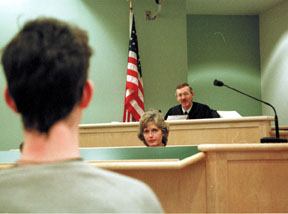Judge Alan Hancock chatted with a teenaged boy about music theory, his parent’s divorce and school work in open court last Thursday.
He called a girl on the speaker phone and cheerfully spoke to her about her baby, her efforts to get a driver’s license and her 12-step treatment program while the others in court listened on.
Hancock ended each conversation with a happy, “Keep up the good work.”
These friendly talks between judge and teenagers are part of a new program designed to help young people who committed criminal offenses kick their drug or alcohol problem.
It’s called the juvenile drug court. It’s a year-long program involving a lot of personal attention from juvenile justice officials along with tailor-made requirements for each juvenile offender. The kids have to appear before Judge Hancock regularly to discuss their lives. They also have to go to treatment, keep in contact with their probation officer and submit to regular urinalysis.
In return, the teenagers who complete the program will get their crimes removed from their records.
So far, the program has been a success. The drug court had its first graduation last month. Hancock said the teenage boy’s attitude about drugs “turned around 180 percent.”
“He became an advocate of living a drug-free lifestyle,” Hancock said. “We are very pleased that we were able to help him make that turnaround.”
The four other teenagers in the program have shown much progress and have stayed clean and sober, with only one relapse.
In court, the teenagers seemed genuinely excited to talk to Hancock about their lives and struggles.
Mimi Buescher, a Coupeville attorney with Platt and Arndt, represents the juveniles in the drug court. She said the kids themselves think it’s a “fabulous” program. The secret of the success, she said, is positive reinforcement.
“The most positive aspect, in my opinion,” Buescher said, “is the notion of treating the juveniles therapeutically versus punitively. It goes back to the idea of listening to a kid with a problem instead of hammering him or her for some sort of violation.”
Channing Gredvig, the drug court probation officer for Juvenile Court Services, said a kid who commits a crime that is somehow drug-related — whether directly or indirectly — may qualify for the program. They have to volunteer and go through an alcohol and drug evaluation to see if they are candidates for drug court.
Gredvig said the idea behind the program, which is based on similar programs in other counties, is that drug abuse is often at the root of juvenile crime. Helping kids kick the habit, he said, should help them stay out of the court system.
Once in the program, the juvenile enters a contract with the court to go to treatment, come to court regularly and submit to drug testing. In addition, each juvenile may have other tailored requirements to help them stay on the right track. That may include not missing school, getting a job or following their parents’ household rules.
Gredvig interviews the teens and their families and stays in close touch with them throughout the program. The drug court is run in phases. In the first six months, the juveniles have to appear in drug court every other Thursday. After that, they only have to appear once a month for the last six months of the program.
Gredvig, Buescher and Deputy Prosecutor Margot Carter meet with Hancock in his chambers for at least a half an hour before each hearing to go over each juvenile’s history and to keep current on their lives. Then Hancock goes over the information with the kids in court.
“The key to the success of the drug court is the judge’s investment and interest in them,” Gredvig said.
Gredvig said the teenagers currently in the program reveal the diversity of the ways and reasons kids with many different backgrounds get into drugs and alcohol.
There’s a girl who used speed because she felt she had a weight problem. One boy used marijuana constantly and another drank heavily. One girl was into shooting up heroin and cocaine, but wanted to quit when she got pregnant.
Three of the juveniles had been arrested for minor in possession offenses while one was facing a car theft charge.
“The idea is that if a child was free from drug and alcohol,” Gredvig said, “they may not be making the decisions they are making.”
Hancock said his only concern about the program is the number of kids involved. While there are only four teenagers in juvenile drug court now, he would like to have at least 15.
Yet Buescher said the low numbers of kids involved is because of the newness of the year-old program. She said there will certainly be more involvement in the future. In addition, she hopes the community will take an interest in the program and show support.
“These kids really do deserve positive reinforcement,” she said. “This program is a great opportunity for the community to get involved with juveniles. … the community really could step up to the plate.”




